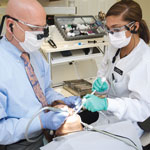
For me, dentistry was not fun. I had my own practice with a decent number of patients, and I spent my days doing what I thought dentists did: checkups, fillings, and the occasional crown. My father always said, “If you are in something, either get in all the way or get out.” I was at that point. If someone had made a decent offer for my practice, I would have taken it. It was against this backdrop that I determined change was needed. I didn’t know what that change was, but I knew I needed to find it.
A few weeks later, a colleague of mine suggested that I attend a seminar offered by the Dr. Dick Barnes Group. He even offered to pay for the course. With the need to change still fresh in my mind, I took him up on his offer. The course was “Full Arch Reconstruction” taught by Dr. Jim Downs. It was the beginning of a journey that changed and continues to change my life and my practice. I would like to share one aspect of this journey: the Seven Slides.
I can still remember the first time I popped the “Seven Slides” CD into my laptop while waiting at the airport. When I saw the first images I thought, “You have got to be kidding! These pictures look like they are from the 1970’s. There is no way these could possibly work.” I was about to throw the disc out when I realized that I needed to give it a chance. I decided to take a leap of faith and give what I had seen a try.
I have probably shown those slides 500 times now, and though I can’t really remember what the first time was like, or the words I used, I can say that each patient’s response is always “WOW!” I now have a copy of the slides on every computer in my practice, and I use them at least 2-3 times a day.
I am no authority on case presentation, but I will tell you that these slides have changed the way I interact with patients in two critical ways. First, the slides establish the narrative of dentistry’s potential. Second, they keep the conversation focused on the patient and not me.
Like most dentists, when presenting a case plan to a patient I would describe what needed to be done. I would say things like “We are going to reduce the tooth on all sides by 2mm” because that was the language of dentistry. The problem is that the patient isn’t a dentist, and I confused people by using terms that reassured them of my expertise. Instead of helping patients get excited about dentistry’s potential, my approach made them wonder how expensive my course of treatment was going to be.
When I started using the slides, I noticed that my case presentations sounded less like sales pitches and more like stories. They became narratives of possibility. As patients saw people facing the same challenge or problem, they could identify with them. When patients saw the final slide they would look at me and say, “Wow, can you really do that for me?” They had finally caught the vision of comprehensive dentistry!
Instead of just sitting there and saying “uh-huh” repeatedly, patients started asking questions and expressing what they wanted as an outcome. The simple act of helping patients see the potential of what comprehensive dentistry could do created a meaningful dialogue that they could understand and participate in. We weren’t just talking about a fee for service; we were having a conversation in which the patients were sharing their vision of desired outcome.
I have often thought of changing out those photos for newer, better-looking images from more recent patients, but something stops me. The “Seven Slides” are not the prettiest things out there, but they seem more honest than the “doctored” before-and-after images that I used previously. The honesty of those slides is disarming, and I personally believe they diminish the natural cynicism toward what we perceive to be “photoshopped” images. The story told in the “Seven Slides” is real to the patients, because the images feel real.
Before I started using the “Seven Slides,” most patients wanted to do only what their insurance would cover. To them, dentistry was an expense, not an investment. They had some idea of how they would like to look, but without the story of what could be, they let their insurance dictate what would be. These slides have helped me present the potential of dentistry in such a fashion that the patient immediately sees the value. Once they catch that vision, price merely becomes a means to an end and not the case’s defining element.
The slides have kept the dialogue on the patient and not me. Prior to using the slides, I would present the dentistry that I thought was best based upon my skill level, or upon my impression of what the patient could afford. The inherent problem with telling patients what they need is that they respond with “How much is this going to cost?” If all they can see is the price, then we as dentists have failed to present the value in terms they understand.
I remember the days when a large case presentation could take upwards of 45 minutes. I would talk the whole time while the patient sat and listened, saying very little. Because I was doing all of the talking, the focus appeared to be all about what I could do rather than what they wanted the outcome to be.
With the slides, I can present a compelling narrative about possible outcomes in a matter of minutes. The rest of the time I spend listening to my patients, letting them direct me as to what outcome they personally want. This is possible because they can see the slides, and without even knowing the terminology, they can help establish the vision that will guide their treatment. At the end of the case presentation, I feel like we have connected and are discussing dentistry in terms of value rather than price.
The power of these slides was made apparent in a recent presentation for a 71-year-old woman who had been my patient for the past few years. She would come for a checkup and have her partial tightened. Each time she would comment on how much she disliked that partial. Before I went to the “Full Arch Reconstruction” course, the only thing I could do was tighten that partial. I just didn’t have the skills or confidence to be able to propose and execute a comprehensive treatment plan for her.
Later, having acquired new skills, I decided to put the Seven Slides to the test. When she came in for her next visit, I pulled up the slides, presented the potential of what could be done, and discussed with her what she wanted as an outcome. After 15 minutes of good dialogue, my patient said she would have to think about it. Usually when patients say this, I don’t expect to see them moving forward any time soon.
To my surprise, the following day the woman returned to my office, told me she wanted to get the procedure done, and wrote out a personal check. When I asked what made the difference, she responded that she saw in those pictures a story not unlike hers. If the patient could get an outcome like that pictured in the slides, then she would be foolish not to invest in herself.
I am a firm believer in the power of the Seven Slides. I have used them and have seen for myself how they help patients catch the vision of what dentistry can do. I have no doubt that by using these slides you can become a better dentist. If after showing these slides to patients you find that they are asking for something you don’t think you can do, you know it’s time to add to your skill set.
I can honestly say that I am now “all in” when it comes to my dental practice. I have found a level of satisfaction that I did not know existed. By presenting comprehensive dentistry, I am able to make in a few hours what used to take days. More importantly my patients are leaving my office feeling a valued part of getting the outcome they didn’t even know was possible before. The number of new referrals tells me that they are sharing their new vision and outcomes with their friends and family.
For more information about Over the Shoulder seminars or to order the Seven Slides, visit Arrowhead Dental’s website or call 1-800-572-7200.
















